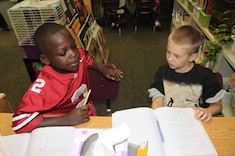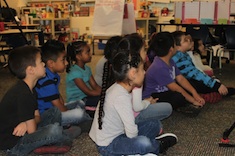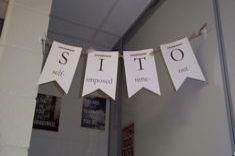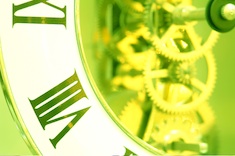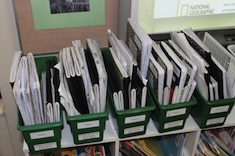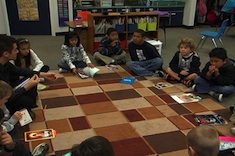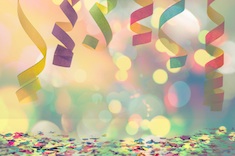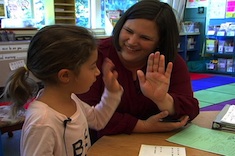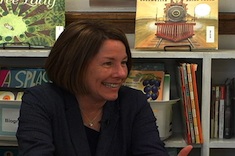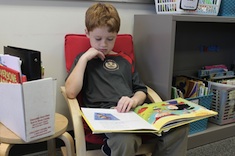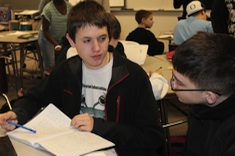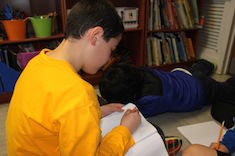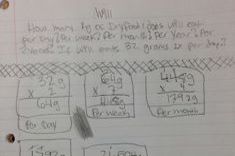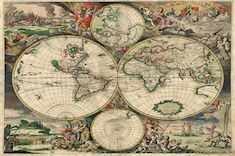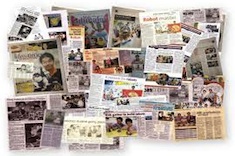Library
Choice Literacy Articles & Videos
The Choice Literacy library contains over 3,000 articles and 900 videos from 150+ contributors. Classic Classroom and Literacy Leadership subscribers have access to the entire library. Content is updated continuously, with five to six new features published each week.
Latest Content
Setting the Stage for Meaningful Peer Feedback
Tara Barnett and Kate Mills develop a scaffold with an index card to help student partners move from agreeable talk to suggestions for revising writing.
Shared Reading in the Digital Age
Shari Frost finds that shared reading routines are easier to implement now because of tech tools.
SITO: Self-Imposed Time-Out
Christy Rush-Levine takes an oddly shaped unused nook in her classroom and turns it into a charming space where students can choose to take a quiet break with a “Self-Imposed Time-Out” (SITO).
Slow Down
Gretchen Schroeder has three strategies for slowing down with her high school students and savoring literacy learning.
The Big Fresh February 6, 2016 Lessons from the Electrician
This week we look at different ways to press the pause button and think about what’s working and what isn’t.
Planning and the Tuesday Effect
Mary Lee Hahn realizes how much a workshop approach has changed her planning process and comfort level with the unexpected.
Pausing for Reflection in Second Grade
Sean Moore helps his second graders remember the classroom routines and protocols for sharing reading reflections through a circle group.
Getting Creative with Writing Celebrations
A celebration is the pause that refreshes between writing units for many teachers. Melanie Meehan shares suggestions for creative celebrations.
The Big Fresh January 30, 2016 What’s New and Good?
We consider student independence in this week’s Big Fresh.
The Compliment Conference
Katrina Edwards confers with Camilla, a struggling reader. She is a child who has no confidence in herself. The Compliment Conference is a way to acknowledge and build upon Camilla’s strengths, and boost her self-esteem at the same time.
Maintaining Momentum As a Writer
Jennifer Richard Jacobson chats with a group of fifth graders about how to generate ideas for writing independently each day.
Wonder and React
How do you scaffold students for independent work? Melanie Meehan finds Wonder and React is a great strategy to use with fifth graders during an information writing unit.
Growing Toward Independence
Cathy Mere shares what to look for and what to try next with young learners who are easily distracted and struggling to concentrate during independent reading.
The Big Fresh January 23, 2016 No Balance
Time for what matters is the focus of this week’s Big Fresh.
Kindergarten Reading Conference: Building Confidence
Mandy Robek finds that kindergartner Mikey is lost in knowing how to use his time well during reading workshop. Her conference moves him from deflated to inspired.
Time for What Matters
Gretchen Schroeder has only 42 minutes with her high school students each day. She explains how she establishes priorities.
Building Stamina in Middle School Writers
Carly Ullmer finds herself wasting a lot of time because of interruptions during student conferences, so she makes building stamina in her middle school students a priority.
The Big Fresh January 16, 2016 Must Be Present to Win
We look at the writing process (and processes) in this week’s Big Fresh.
The Big Fresh January 9, 2016 Secret Messages
Content literacy is the focus of this week’s Big Fresh.
“Giving Ourselves Hard Problems”: Rethinking Math Workshop
Mary Lee Hahn rethinks her math workshop structure to more closely align with the choice and problem solving in her reading and writing workshops.
The Intersection of Social Studies and Language Arts
Melanie Meehan writes about how teachers in her state are dealing with the time-crunch issue in social studies instruction by naturally integrating more social studies into the language arts program.
Extended Inquiry with Article of the Week
Gretchen Schroeder finds the article of the week activity is an excellent vehicle for learning about content literacy gaps in student background knowledge and how to fill them.
Risk and All
Tom Romano meets with Kacie, a student writing about an experience that shames her. He ponders the importance of facing the darkest parts of our experiences when we write. This is an exclusive excerpt from Tom's new book, Write What Matters.
The Big Fresh December 19, 2015 Unexpected
English language learners are the focus of this week’s Big Fresh.
Debating How to Begin Stories
Melanie Meehan shares a minilesson using student writing as a model for experimenting with leads.
Conferring Over “Finished” Writing
Ruth Ayres challenges Grant to add paragraphs to his “finished” piece.
Exploring the Writing Process
Dana Murphy considers the differences between authentic writing processes and what we teach in schools.
Modifications for English Language Learners
Stella Villalba shares some modifications that can help English language learners demonstrate skills and knowledge.
Knowing Ami: Silent Communication with an English Language Learner
Katie DiCesare finds patience and observation are the keys to helping a first-grade English language learner who is in the silent period.
Owl Research Brainstorming: Partner Work
Andrea Smith’s fourth graders are working on an Owl Research project that integrates reading, writing, talking, listening, and content literacy.
Browse Content By
Type
Category
- Assessment Tools
- Big Fresh Archives
- Booklists
- Choice Numeracy
- Classroom Design
- Common Core
- Community Building
- Conferring
- Content Literacy
- Digital Literacy
- English Language Learners
- Equity
- Family Relations
- Free Samples
- Guiding Groups
- Leadership
- Literacy Coaches
- Mentor Texts
- Minilessons
- New Teacher Mentors
- Podcasts
- Poetry
- Quote Collections
- Reading Strategies
- Self Care
- Struggling and Striving Learners
- Talking and Listening
- Teacher Study Groups
- Teaching Reading
- Teaching Writing
- Word Study and Vocabulary
Author
- Melissa Quimby
- Nawal Qarooni
- Gwen Blumberg
- Julie Cox
- The Lead Learners
- Hannah Tills
- Josie Stewart
- Ruth Metcalfe
- Mallory Messenger
- Becca Burk
- Jodie Bailey
- Vivian Chen
- Mary Brower
- Tiffany Abbott Fuller
- Stephanie Affinito
- Ruth Ayres
- Leigh Anne Eck
- Heather Fisher
- Shari Frost
- Julie Johnson
- Suzy Kaback
- Gigi McAllister
- Shirl McPhillips
- Melanie Meehan
- Cathy Mere
- Debbie Miller
- Tara Barnett and Kate Mills
- Tammy Mulligan
- Dana Murphy
- Bitsy Parks
- David Pittman
- Brenda Power
- Heather Rader
- Matt Renwick
- Mandy Robek
- Christy Rush-Levine
- Gretchen Schroeder
- Jen Schwanke
- Brian Sepe
- Katherine Sokolowski
- Stella Villalba
- Jennifer Vincent
Grade Level
Choice Literacy Membership
Articles
Get full access to all Choice Literacy article content
Videos
Get full access to all Choice Literacy video content
Courses
Access Choice Literacy course curriculum and training

